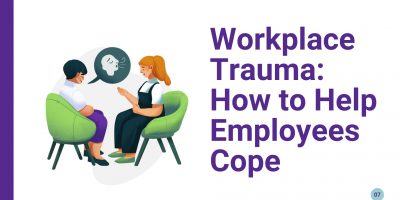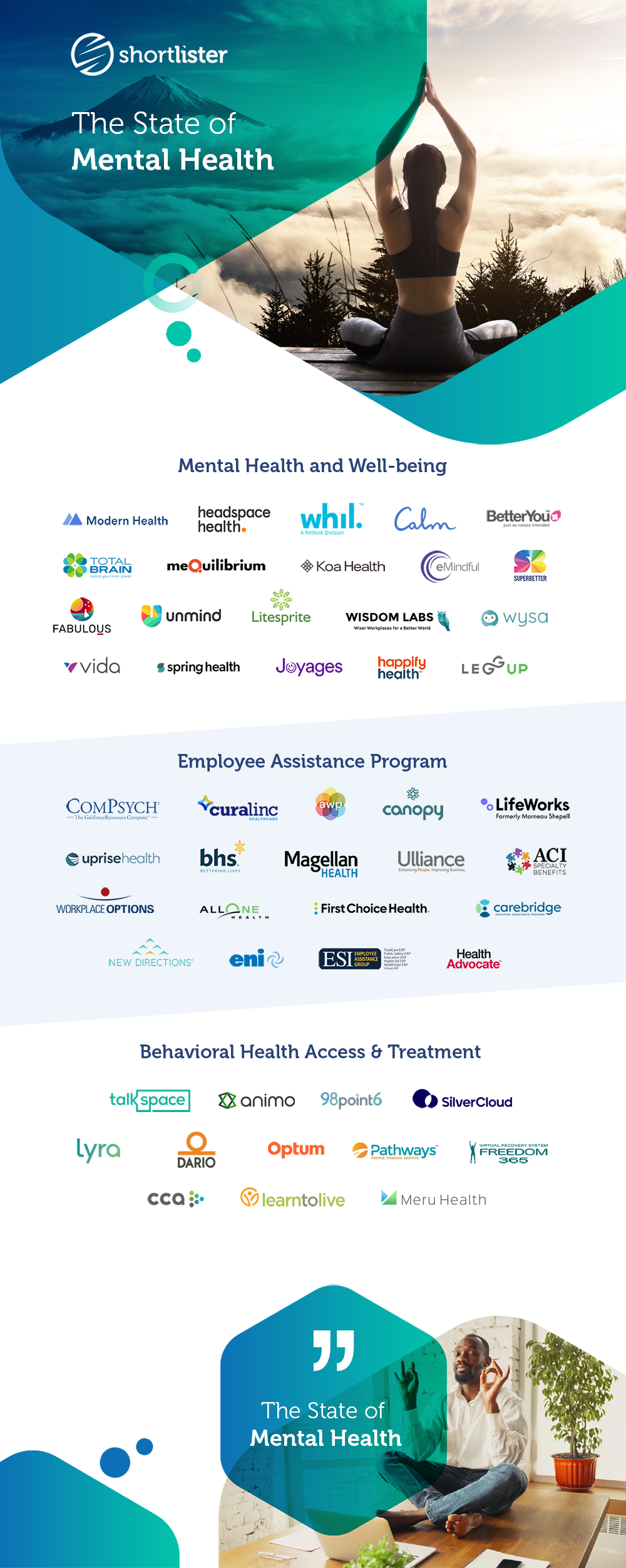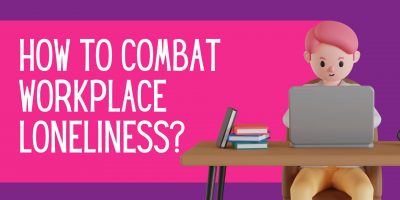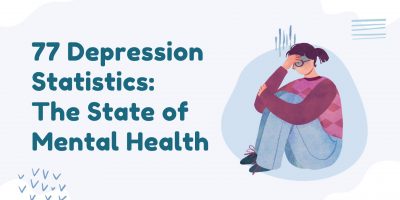
Workplace Trauma: How to Help Employees Cope
Learn to recognize workplace trauma early on, address it correctly, and support struggling employees throughout their emotional recovery.


Fast-paced work environments, heavy workloads, and work-related stress limit employees’ ability to perform at their highest level. Workers from every industry face anxiety, depression, and other mental health issues in the workplace, making mental health and emotional wellness a top concern for employers.
Mental health problems directly impact workplaces by reducing productivity, while increasing absenteeism and healthcare costs. The importance of well-being programs is near-universal acceptance in the corporate world.
Supporting mental health is no longer an optional component of a comprehensive well-being strategy, but a necessity.
When employers prioritize employees’ mental well-being, they reduce the stigma associated with mental health issues, address disparities in their treatment, and provide help through formal structures and programs.
To adequately support behavioral health consumers, Shortlister is dedicated to following the changing conditions of the workplace and highlighting any unmet mental health needs. By gathering and providing up-to-date information about the latest mental health tools and offerings, organizations are better equipped to respond to, anticipate and innovate to meet people’s evolving needs and maximize program benefits.
The social and economic disruptions caused by the COVID-19 pandemic exacerbated the mental health crisis.
To assist employees facing these stresses, employers increased the use of digital technologies to provide access for remote and flexible workers to human-centric health care solutions.
In particular, employers found behavioral health programs as an effective way to connect employees to mental health services and keep their workforce productive and thriving.
Behavioral health is often used interchangeably with mental health, but it is a far more expansive term that encompasses not just our mental wellness but our daily cognitive habits, behaviors, and overall well-being.
This can include everything from eating a healthy diet to managing an existing disease or injury. Research suggests that mental health, physical wellness, and behavioral health are all closely related.
In fact, 68% of adults with mental health issues also struggle with medical conditions. Therefore, we have expanded Shortlister’s Behavioral Health and Mental Well-being coverage to include:
Through online therapy and self-guided mental health apps, employees can manage and overcome negative behaviors, develop healthy habits, and nurture overall wellness.
As mentioned above, behavioral health focuses on building healthy habits and their effect on our well-being.
Behavioral health treatments aim to change behaviors, emotions, thoughts, and employees’ perceptions of various situations through counseling and other psychotherapies. It also encourages employees to lead a balanced life and adopt healthy practices.
Through research and conversations with benefit providers, employers, and consultants, Shortlister has identified a broader range of behavioral health offerings, especially those powered by technology. There is a growing acceptance and demand for digital behavioral health tools such as:
Although many mental health professionals emphasize the benefits of in-person therapy (non-verbal communication, easier rapport between therapist and patient, etc.,), we at Shortlister observed new providers entering the market with the primary goal of eliminating barriers to traditional behavioral health care.
As the most significant barriers to care are access, affordability, and stigma – the flexibility of digital tools can mitigate all of these problems.
Additionally, digital tools and data derived from care technology can support and improve clinical outcomes and give more profound insights into optimizing patient care and treatment plans.
Technology offerings play a significant role in ensuring every employee has access to behavioral healthcare when they need it and wherever they need it.
An Employee Assistance Program (EAP) is an employee benefit program that assists employees with personal and work-related problems that may adversely affect the employee’s performance.
Traditionally, EAPs have helped workers with issues like substance and alcohol misuse, but now cover a wide array of issues like:
EAPs are like a vast umbrella that fits different types of benefits in one package.
Despite the fact that most EAP providers tout an extensive list of offerings, Shortlister has surfaced some important factors that differentiate EAP providers, such as service guarantees to ensure that employees can access all the promised services, is the size and geographic range of counselor networks, whether counselors are contracted or employed directly by the EAP, and whether counselors are licensed or possess advanced degrees.
Typically, EAPs provide a limited number of short-term behavioral health counseling sessions at no cost to workers. Services are often delivered via phone, online chatting, video-based counseling, e-mail interactions, or face-to-face.
Most often, EAPs help address short-term distractions that affect employees’ jobs. If the problem persists, employees can get referrals to mental health professionals and other services.
In addition, these services are usually made available not only to the employee but also to their spouse, children, and non-marital partners living in the same household.
Through our research, we at Shortlister consistently identified stigma as one of the primary barriers to getting help for behavioral health problems. That is especially true for those suffering from addiction. Vendors in the addiction treatment space are fighting against the mistaken belief that those who abuse substances simply lack the willpower or moral principles to stop. In reality, drug and alcohol addictions are complex medical diseases. Quitting usually takes more than a strong will or good intention.
However, given the stigma attached to addiction, many employees may be reluctant to seek help for fear of getting fired. With anti-stigma campaigns, education, and support through DEI efforts, corporate culture needs to set the tone for addiction problems.
Today, we recognize addiction as a chronic disease that alters brain structure and function. There is no one-size-fits-all treatment, as the needs, level of care, and personal mental health needs vary between individuals.
Most addiction treatment programs include:
Shortlister has also identifed an increasing number of vendors providing support for those suffering from non-substance, or behavioral, addictions.
Behavioral addictions are described as an intense desire to repeat some action that is pleasurable or capable of alleviating some personal distress. Some of the most prevalent behavioral addictions are related to:
After two years of remote work arrangements, the work-life balance was erased for many employees and made it easier to engage in addictive behaviors during the workday. For that reason, employers have increasingly relied upon addiction treatment services as more people turn to addictive behaviors to alleviate stress and boredom.
While mindfulness and meditation offerings are considered quite a niche, we at Shortlister have received increasing requests from forward-thinking companies seeking to use meditation techniques to cope with today’s ever-changing and stressful work environment.
Through mindfulness, employees can gain focus and clarity, allowing them to work smarter and feel better.
Most mindfulness and meditation programs are self-guided. They offer a variety of tools for employee mental health, such as:
Bringing mindfulness to the workplace has many benefits to employee well-being – both mental and physical.
Pursuing mindfulness promotes mental resilience, reduces stress and anxiety, and creates a thriving workforce. Companies looking to expand their wellness offerings and promote a better work-life balance should not overlook meditation and mindfulness programs.
Browse our curated list of vendors to find the best solution for your needs.
Subscribe to our newsletter for the latest trends, expert tips, and workplace insights!

Learn to recognize workplace trauma early on, address it correctly, and support struggling employees throughout their emotional recovery.

Loneliness can be a serious problem affecting not only employees’ mental health but also the bottom line for businesses. What are the tell-tale signs of workplace loneliness, and what can employers and organizations do to reduce or mitigate it?

How important is building relationships and social wellbeing to our health? Do social connections translate to a more satisfying and productive work experience?

Gain valuable knowledge on the prevalence, demographics, and impact of depression, providing a deeper understanding of the challenges faced in today’s society.
Used by most of the top employee benefits consultants in the US, Shortlister is where you can find, research and select HR and benefits vendors for your clients.
Shortlister helps you reach your ideal prospects. Claim your free account to control your message and receive employer, consultant and health plan leads.